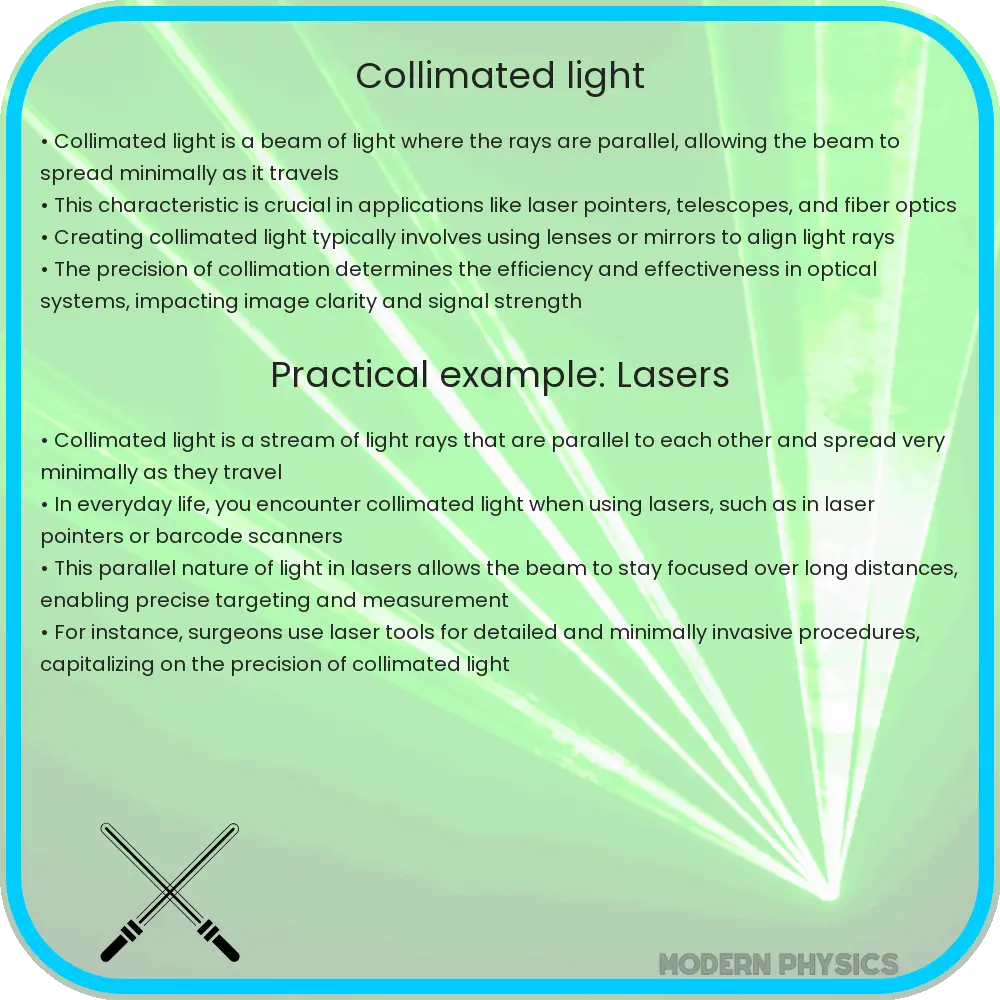Explore the world of collimated light in optics: its properties, creation methods, and diverse applications in technology and science.

Understanding Collimated Light in Optics
Collimated light, a concept central to optical engineering and physics, refers to light beams that are parallel and do not diverge or converge over a significant distance. This phenomenon is key in applications requiring precision and uniformity.
Properties of Collimated Light
The primary characteristic of collimated light is its parallel rays. In a perfectly collimated beam, all light rays are parallel to each other, leading to negligible spread or divergence even over long distances. This property is contrasted with typical light sources, like bulbs, where light diverges in all directions. The degree of collimation can be measured by the beam divergence, typically quantified in milliradians or degrees.
Creating Collimated Light
Collimated light is typically produced using lenses or mirrors. A common method involves passing light through a collimating lens. This lens takes diverging light from a point source and adjusts it into a parallel beam. Similarly, parabolic mirrors, with their unique shape, reflect light in a manner that forms collimated beams. Lasers naturally emit highly collimated light, making them vital in applications demanding high precision.
Applications in Optics
Collimated light finds extensive use in various optical applications:
- Telescopes: Astronomical telescopes use collimation to ensure that starlight, which travels vast distances and arrives essentially collimated, is accurately focused, providing clear celestial images.
- Spectroscopy: In spectroscopy, collimated light is essential for accurate measurements, as it ensures uniform illumination and precise spectral analysis.
- Laser Optics: Lasers, inherently producing collimated light, are crucial in applications like laser cutting, medical surgeries, and scientific research.
- Fiber Optics: In fiber optics, collimated light enhances signal transmission over long distances with minimal loss.
Moreover, collimated light plays a pivotal role in photography and cinematography, providing uniform illumination that is essential for high-quality imaging.
Next, we will explore the precision and uniformity aspects of collimated light and delve deeper into its specific applications in various fields of optics.
Precision and Uniformity of Collimated Light
The precision of collimated light lies in its ability to maintain coherence and direction over long distances. This feature is crucial in applications requiring high accuracy, such as alignment and calibration tasks in engineering. Uniformity, another key aspect, refers to the consistent intensity across the light beam’s cross-section. Uniform collimated beams are essential in applications like holography, where even illumination is critical for capturing detailed interference patterns.
Advanced Applications of Collimated Light
Collimated light’s unique properties have led to its integration into advanced technological applications:
- Lithography: In semiconductor manufacturing, collimated UV light is used for photolithography, enabling the creation of intricate circuit patterns on silicon wafers.
- 3D Scanning: Collimated lasers in 3D scanning systems offer precise distance measurement, crucial for creating accurate three-dimensional models.
- Optical Communication: In the field of optical communication, collimated light beams enable high-speed data transmission with minimal signal degradation.
- Medical Imaging: Collimated X-ray beams are used in medical imaging, reducing scatter and improving image clarity, which is vital for accurate diagnostics.
Challenges and Future Directions
Despite its advantages, working with collimated light presents challenges. Maintaining perfect collimation over very long distances is difficult due to external factors like atmospheric disturbances. Future advancements are focusing on overcoming these limitations, particularly in space-based applications where collimated light can be used more effectively due to the absence of atmospheric interference.
Research is also directed towards developing more efficient collimation techniques and materials, enhancing the precision and utility of collimated beams in various scientific and industrial fields.
Conclusion
Collimated light, characterized by its parallel rays and minimal divergence, is a cornerstone in modern optics. Its precision and uniformity are invaluable in a multitude of applications, ranging from astronomy to medical imaging. While challenges exist in maintaining perfect collimation, ongoing technological advancements promise to extend its capabilities further. The significance of collimated light in pushing the boundaries of scientific and technological innovation cannot be overstated, making it a fascinating and continually evolving field of study.
Is this conversation helpful so far?
